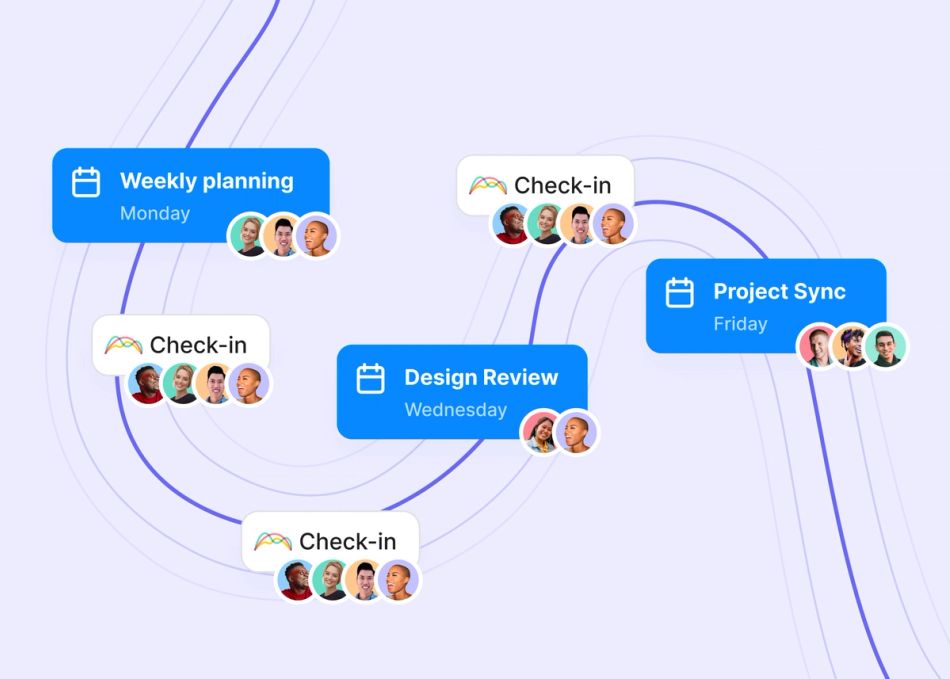
How do you know when to hold team meetings? It's a difficult question. If you hold them too often, team members will see them as an inefficient burden on their time, get bored, and stop engaging.
According to BetterMeetings, 78% of people surveyed feel that their meeting schedule is either always or sometimes out of control.
However, if you don't hold meetings often enough, your team objectives can get off track and your results could suffer from lack of brainstorming and collaboration. Remote team members could also start feeling isolated and disconnected, which can damage their morale
Deciding on the perfect meeting cadence for your remote team is essential to balance the line between not meeting enough and meeting "all the time."
To achieve an effective team meeting cadence, meeting leaders need to understand how to set a cadence, refine the meeting cadence over time, and use collaboration tools to increase meeting efficiency and hold better meetings.
What is a meeting cadence?
A meeting cadence simply refers to the number of meetings you have, when you have them, and how long they are.
Your meeting cadence can be bi-weekly, weekly, bi-monthly, monthly, or quarterly. Following a bi-monthly meeting cadence, for example, means your team meets twice a month.
The concept of a meeting cadence is important for running successful meetings because the right meeting cadence can increase productivity and team effectiveness. Meeting too often or not enough can sabotage your team's success, and hinder its ability to make decisions and put project management initiatives in place.
Important questions to ask before you set your meeting cadence
Don't just automatically decide that weekly team meetings or monthly meetings are the best cadence for your team. There are several considerations to take into account when trying to establish the right cadence.
Here are a few questions that managers can use when trying to build a meeting cadence strategy:
- "What is the goal of this meeting?" Depending on the objective, you may need to meet more often, or not as much.
- "Can this meeting happen asynchronously?" Do you need to meet in person, on Zoom, or will another channel like email or Slack be the best option?
- "Is this a high-priority or urgent task?" If there's a deadline approaching, or a critical project on the books, a more frequent meeting cadence may be necessary.
- "Do these types of meetings regularly run over the allotted time?" If so, it may be more effective to meet more often.
- "Do we run out of items to discuss in these types of meetings?" A lean or empty meeting schedule may be a sign that you're meeting more often than necessary.
- "Do we often run out of time discussing action items in these meetings?" If you never have enough time or don't get to the bottom of your meeting agenda, you need to meet more often.
- "How many people will attend these meetings?" If there are several people attending, your meetings may be more effective if you break them up into smaller meetings with fewer people.
How to select a meeting cadence
Deciding on the right meeting cadence depends on the type of meeting you're conducting.
Team leaders must consider the meeting attendees, the meeting facilitator, the topic that you'll be covering, and your company. Every business is unique and what's best for one may not work well for another.
Be aware you may not find your perfect meeting rhythm right away, so don't lock yourself into a meeting cadence forever.
Take a transparent, proactive approach with your team, and announce that you will try a new meeting cadence for a while — and if it doesn’t work, you can revisit it in the future.
Consider the type of meeting you’re running when choosing a cadence
The category of meeting cadence depends on what you want the meeting to accomplish. Here are some of the most common cadences to choose from:
Daily meetings
Daily meetings work well for check-ins, to update team members on pending tasks, and discuss the obstacles blocking their progress.
Meetings that fall under this category are:
- Daily standup meetings: They are so short, team members don't even need to sit down. These can also be called a “daily huddle.” The point of these meetings is to quickly run through everyone's tasks for the day. Stand-up meetings should last no more than 20 minutes.
- Team check-ins: A daily check-in are async updates that can be done directly in Range. These will let everyone know what you're working on that day, and what you may need help with. There are also mood check-ins and questions to get the whole team talking. Takes about 5 minutes!
Weekly meetings
A weekly meeting cadence is helpful for getting the team together to review the last week’s progress, and to go over what's on tap for the upcoming week. They're typically held on the same day at the same time every week.
Meetings that fall under this category are:
- Department team meetings: Each team member can address their hotlist, give status updates, or discuss any bottlenecks they are experiencing. These can last anywhere from one to two hours.
- One-on-one meetings: Meetings don't have to have a dozen people. Some only have two! The one-on-one meeting cadence is a weekly meeting between the team leader and their direct report(s). During this meeting, the direct report shares specific information about the projects they’re working on, and managers provide feedback, insights, and guidance. These meetings are doubly valuable for remote team members, who typically don’t get much synchronous face time with their managers. One-on-ones are typically less than an hour long.
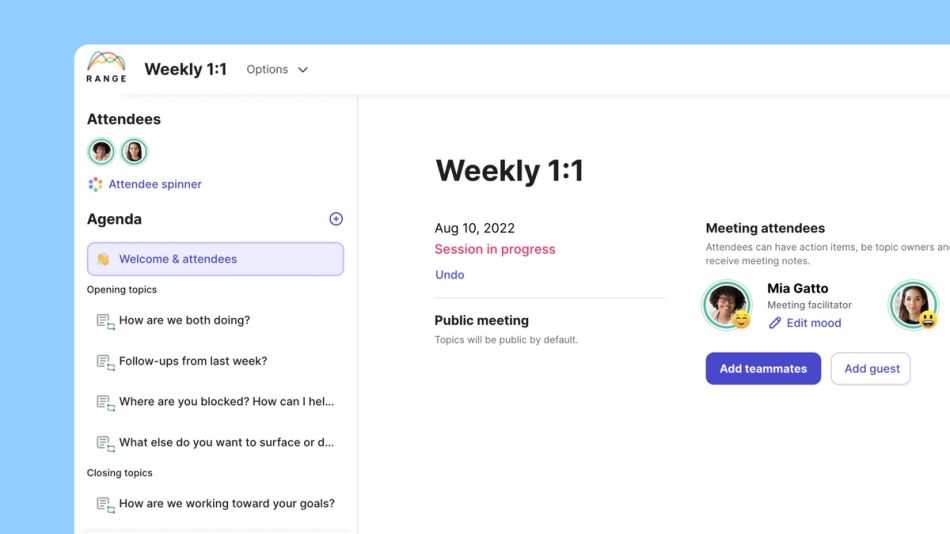
⭐️ Keep your meeting history and notes in one place.
⚡️ Try a meeting template in Range.
Monthly meetings
Some examples of monthly meetings are:
- All-hands meetings: Everyone in the company joins this monthly meeting to share updates and hear announcements. Upcoming changes or shifts in company policies are typically announced at all-hands meetings. Plan to set aside about two hours for these meetings
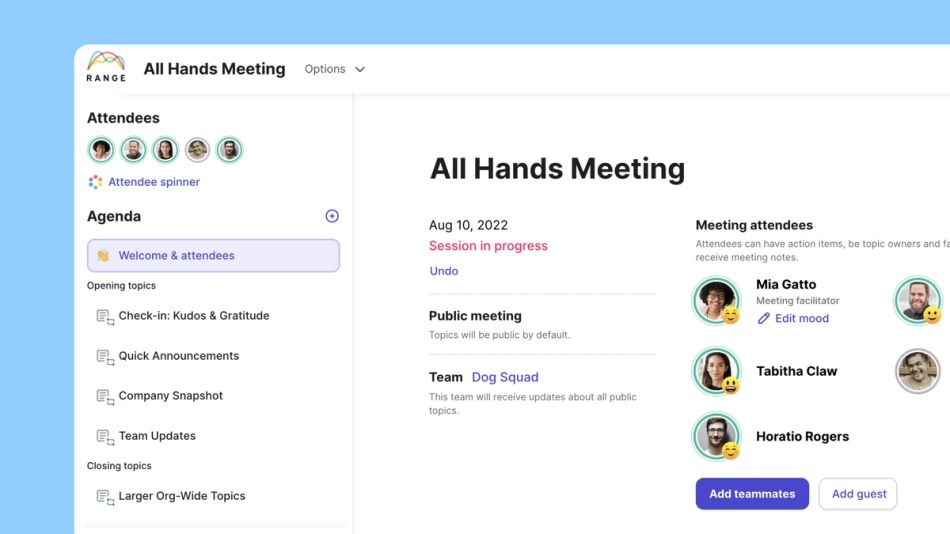
- Leadership meetings: The leadership team, which is made up of managers from each department, meets once a month. These meetings take place on a recurring schedule, usually on the same day and time. If managers have been buried in their own departments, this is a chance to get updated on other facets of the business. There's a critical exchange of information during these meetings, which typically last anywhere from two to four hours.
Quarterly meetings
Certain topics are best discussed less often — quarterly meetings work well in these scenarios. Some examples of good quarterly meetings are:
- Board meetings: There's no reason to take up board members' time with a weekly, or even monthly, meeting cadence. Set these meetings up four times a year to update the board on high-level initiatives, investments, and changes. These meetings can last anywhere from three hours to a full day.
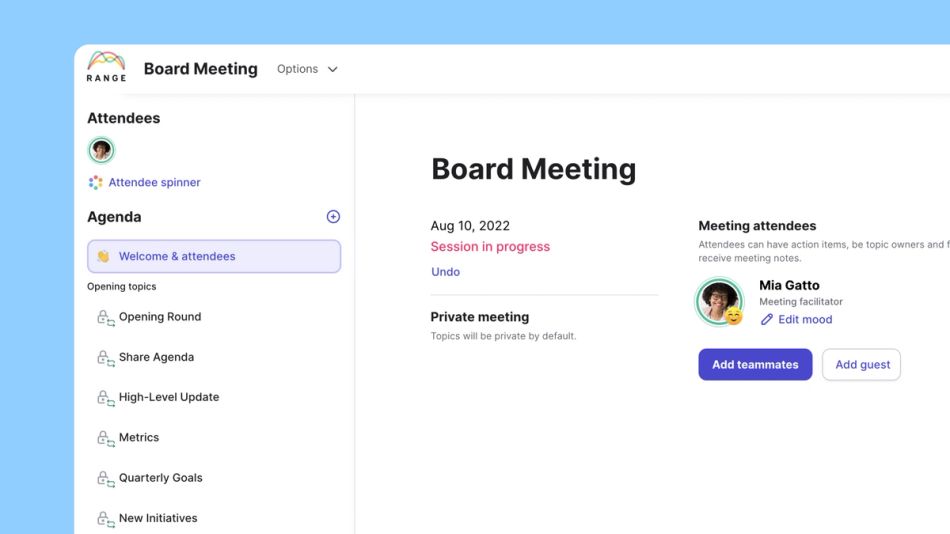
- Business reviews: It's smart to keep an eye on where the business is in relation to sales goals. This meeting allows the stakeholders to review new accounts, sales by product, and efforts to increase sales, ranging from marketing efforts to customer support. This meeting should last about half a day.
Additional meeting cadence tips
Now that you’ve established what schedule is ideal for the type of meeting you’re planning, what else can you do to make sure the new routine is as successful as possible?
Here are a few additional meeting cadence tips to make sure the right people are there, your agenda is prepared, and your communication is on point.
Invite the right teammates
Sometimes, it feels easier to just invite people you're on the fence about, even if it hinders the meeting's effectiveness. Avoid this pitfall.
Only invite the necessary parties to your meeting, then afterward send the meeting notes to anyone else who needs to be privy to the information. This gives the uninvited people more time in their workday and reduces the chance that the meeting will dissolve into ineffective tangents.
Prepare your agenda in advance
“Winging it” may seem like you're leaving room for spirited debate and bouts of creativity, but you're actually setting yourself — and your team — up for failure. Use an agenda template and carefully map out the meeting topics from beginning to end. If you want to include creative time, add it to the agenda.
Use Range to create a meeting agenda and send it to all the attendees so they will know what to expect during the meeting, and can come prepared with questions or updates.
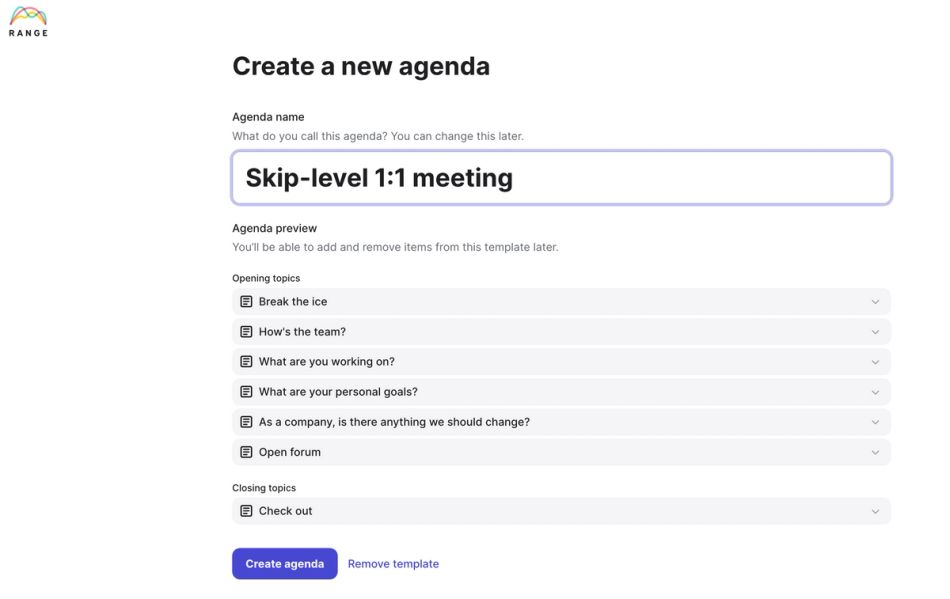
Consider team size
If your team is small, it's easy to have a daily huddle. Circumstances may change if you have a team of a dozen people or more. Think about your team size as you plan your meeting cadence. While nobody loves long meetings, you need to carve out adequate time to hear out your team members’ needs and obstacles — and give everyone a chance to participate.
Consult your team to refine your meeting cadences
Recurring meeting cadences help team members stay on track and frees up time in their schedules to focus on work.
- By setting the date, time, and length of the meeting upfront, the attendees can plan around it effectively.
- Be consistent with meetings but also provide the freedom to adjust and refine meeting cadences to better suit your team.
- If there are other meetings that overlap with yours, or big project deadlines on meeting day, it pays to be flexible and deviate from the schedule that day.
- Keep a pulse on your attendees' needs, and be willing to accommodate them.
Flexibility is key — don’t get too caught up in sticking to your agenda right down to the second. Things come up: Maybe the location of the meeting needs to change from in-person to via Zoom.
Or, perhaps a meeting runs overtime due to a lengthy but productive brainstorming session. It may even be cut short if you and your team members run through agenda items quickly.
Read the room to get a feel for whether or not your team members find the meeting to be useful, and don’t be afraid to adjust accordingly.
Remember, the goal of your meetings should always be to benefit your team members and the company overall. If you implement a new meeting cadence and meetings seem ineffective, lack engagement, or don't offer actionable plans, consider cutting the cadence down to fewer meetings.
What about asynchronous communication?
Asynchronous communication is different from real-time meetings, but they can still achieve the same objective. The above meeting cadence strategies apply to asynchronous communication just as much as synchronous communication.
One major benefit of asynchronous communication is that attendees have the flexibility of participating around their schedules — not the other way around (which is necessary for synchronous meetings).
Establishing a cadence for asynchronous communication is similar to establishing one for face-to-face meetings.
With Range check-ins, your team can:
- Have fewer meetings with async check-ins and waste less time
- Reduce meeting load by keeping every team member informed and connected
- Easily share your work plan and what you accomplished
- Check-in on a personal level and stay in-the-know – from wherever.
- Integrate tools from across your workflow, including Github, Google Docs, Google calendar, and more
- Add tasks from your project management tools
- Share updates via Slack or Microsoft Teams
Change your strategy for asynchronous and synchronous meetings
It’s important not to paint all your meetings with the same brush, as synchronous and asynchronous meetings require slightly different approaches.
Synchronous, in-person meetings are excellent for information-seeking sessions. This includes project kick-offs and one-on-ones, where direct input from team members is highly valuable to the process.
Asynchronous meetings are better suited for information-giving meetings, such as project updates, daily stand-ups, and check-ins.
The synchronous format may work better for quick sharing, while the asynchronous format might be more beneficial for in-depth, long-term collaboration. Again, it pays to think about what you're trying to accomplish, and then decide which format best suits that goal.
Meeting management tools help you host fewer, better meetings
By automating your stand-up and check-in meeting cadences, meeting management tools like Range can free up your attendees' schedules while still providing all the benefits of a face-to-face meeting. Over time, these cadences will become second nature for both on-site and remote team members.
Meeting management software make it easier for team members to engage when it’s convenient for them.
As a manager, tools like Range give you access to team communications, meeting notes, and task follow-ups all in one place.
This gives you better insights into what your team is working on, and what each person has on their plate. Similarly, team members have one-touch access to you and their coworkers, so it’s easy to fire off a question to someone via a chat feature and get a written response that they can refer to later.
Ready to find the perfect meeting cadence for your team?
Figuring out the meeting cadence that's right for your team can be challenging. By planning it thoughtfully and keeping what you want to accomplish at the top of your mind, you can lay out a cadence that doesn't take up too much time, includes the right attendees, stays on track, effectively shares communication, and pushes projects forward.
A good meeting cadence keeps team members updated and focused on their goals, helps pinpoint and overcome obstacles, and provides a way for them to feel included as part of the team.








